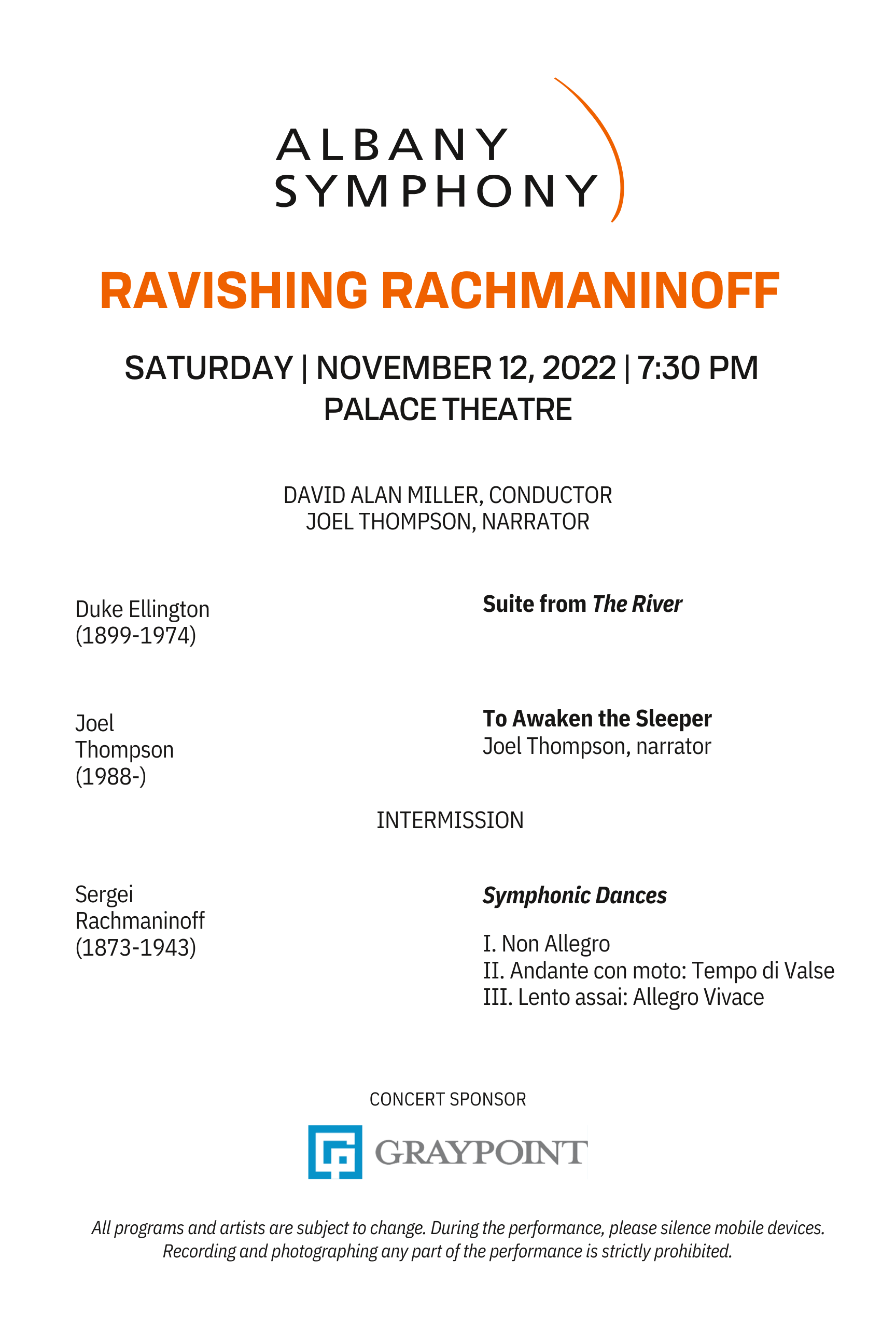Program Notes
JOEL THOMPSON
Joel Thompson (b.1988) is an Atlanta-based composer, conductor, pianist, and educator best known for the choral work Seven Last Words of the Unarmed, which was premiered November 2015 by the University of Michigan Men’s Glee Club and Dr. Eugene Rogers and won the 2018 American Prize for Choral Composition. His pieces have been performed by the Atlanta Symphony Orchestra, Tallahassee Symphony Orchestra, Atlanta Master Chorale, Los Angeles Master Chorale, EXIGENCE, and the San Francisco Gay Men’s Chorus. Currently a student at the Yale School of Music, Thompson was also a 2017 post-graduate fellow in Arizona State University’s Ensemble Lab/Projecting All Voices Initiative and a composition fellow at the 2017 Aspen Music Festival and School, where he studied with composers Stephen Hartke and Christopher Theofanidis and won the 2017 Hermitage Prize. Thompson taught at Holy Innocents’ Episcopal School in Atlanta 2015-2017, and also served as Director of Choral Studies and Assistant Professor of Music at Andrew College 2013-2015. Thompson Is a proud Emory alum, graduating with a B.A. in Music in 2010, and an M.M. in Choral Conducting in 2013.
to awaken the sleeper
To Awaken the Sleeper was premiered by the Colorado Music Festival with Peter Oundjian, conductor, on August 5, 2021. The LPO is a co-commissioner of the work. The piece weaves selections of James Baldwin’s writing into a music profile. Joel Thompson is an Atlanta-based composer, conductor, pianist, and educator, best known for the choral work Seven Last Words of the Unarmed, which was premiered in November 2015 by the University of Michigan Men’s Glee Club and Dr. Eugene Rogers and won the 2018 American Prize for Choral Composition.
“Given the sort of turmoil as it relates to race in our society, Baldwin’s writings were sort of a beacon for me, a source of comfort a way for me to focus my craft,” Thompson shared with CBS Denver. “In the world of classical music in which my identity is historically marginalized, having a space here where in which I can speak and be heard is very important, and Baldwin faced similar obstacles.”
Baldwin’s words will be performed by a narrator as part of the composition... Thompson said that Baldwin wanted to highlight the Black experience in the country and as a composer who has focused his work on topics in America, he attempts to do that as well.
“He had to sort of hold society to account, while also expressing his love for what American can be and not yet achieving,” Thompson said of Baldwin. “Drawing from his words to sort of ask us to look in the mirror and see who we actually are and determine who we can be moving forward.”
DUKE ELLINGTON
“Bestowed posthumously on Edward Kennedy 'Duke' Ellington, commemorating the centennial year of his birth, in recognition of his musical genius, which evoked aesthetically the principles of democracy through the medium of jazz and thus made an indelible contribution to art and culture.”
So reads the special citation by the Pulitzer Prize committee in 1999. Let’s break it down: “Posthumously.” Ellington died in 1974, but before this citation he had received numerous other honors, including honorary degrees from Yale and Berklee College of Music, a Lifetime Achievement Grammy Award, and the Presidential Medal of Freedom
“Musical genius.” In his book The Swing Era, composer Gunther Schuller wrote, “Ellington composed incessantly to the very last days of his life. Music was indeed his mistress; it was his total life and his commitment to it was incomparable and unalterable. In jazz he was a giant among giants. And in twentieth century music, he may yet one day be recognized as one of the half-dozen greatest masters of our time.” These sentiments have been echoed by many critics and music historians.
“Principles of democracy.” From the nightclubs of Harlem to international stages (he was a Jazz Ambassador for the State Department) to movies, he brought the sounds of swing with his famed band. Pieces like “Black and Tan Fantasy” and “Black, Brown and Beige,” by their very titles, celebrated African American life. According to an article by Michelle R. Scott and Earl Brooks, Ellington included a clause in his contracts in 1961 and beyond stating that he would not play before segregated audiences, having suffered for many years the racism accorded to traveling entertainers looking for dining or overnight accommodations.
“Medium of jazz.” It goes without saying, but check out all the Grammys in that category he won.
“Indelible contribution to art and culture. ”See: “Caravan,” “Jump for Joy,” “Honeysuckle Rose,” “Take the ‘A’ Train,” and, perhaps a philosophy for living, “It Don’t Mean a Thing If It Ain’t Got That Swing.”
SUITE FROM THE RIVER
Smetana had his Moldau; Strauss had his Danube. Ellington had—well, probably the mighty Mississippi. This suite is generic enough in its depictions of what happens to water from source to sea that, as with the others, it could apply to any river. The origins in the spring are evoked (drip, drip—the gentle flute and harp); the wandering stream is not particularly lazy but rather sassy (nice brass work). Rapids? Sure, perky, big band sound. And then things quiet down in a lake, where quiet instruments like flute, clarinet, and oboe flourish. The snare drum and syncopation add to the driving music of the fifth episode: vortex. The falls are suggested by rushing music—an incessant triangle and a descending harp. (Gravity rules!)
And then finally, “Two Cities,” a sort of anthem, with brass and sweeping strings. The music was written for Alvin Ailey and his dance company in 1970. About the last episode that Hubert Saal wrote in his review for News week, “In `Two Cities,’ a white girl (Sallie Wilson) and a black boy (Keith Lee), each bathed in a spotlight, dance a blues adagio, expressing yearning and loneliness. Gradually the spotlights unite them, and their pas de deux, touching in the complexity of intertwined limbs and intricate lifts, makes a wordless comment that lays waste racial distinctions.”
Note: Ellington’s son Mercer Ellington suggested that by 1970 his father’s spiritual view of things made him consider the river a metaphor for the pathway of life. Sounds good, too.
SERGEI RACHMANINOFF
Sergei Rachmaninoff left Russia during the Revolution of 1917 at the age of 44 and never returned. For the next 26 years he resided in the United States, where he concertized as pianist and conductor, composed, enjoyed family life with his wife and two children, and became wealthy.
Audiences know his concertos for piano and orchestra nos. 2 and 3 and his Symphony No. 2 well. Advanced pianists wrestle with his sonatas and etudes tableaux. His cello sonata occasionally shows up on a chamber music program. Tonight’s piece, which was last played by this orchestra in 2004, was his final composition (1941) and is a masterpiece.
It’s interesting that the work begins with a series of repeated notes in the strings—no tune, just movement, rhythm. And while there are, to be sure, the kinds of beautiful tunes we've come to expect from Rachmaninoff, it’s the emphases, the syncopation, and the rhythmic punctuation that often capture our attention. Everything drives forward. Dances, after all.
An English horn then announces a quiet section, echoed by the clarinet.A melancholy saxophone deliversa melancholy melody. A piano? In a symphonic work? Yes, for color, followed,naturally, by a big string tune. A return to the energy of the first part of the movement is inevitable—those insistent pulses—but the movement ends tranquilly, the chugging subdued by a restrained chord.
The middle movement is a weird waltz. Muted trumpets blat eerily. The violin that takes center stage is also off-putting. The waltz kicks off with yet a third spooky sound, the English horn. When, exactly, is this dance taking place? If we consult Rachmaninoff’s original names for the three movements—“Noon,” “Twilight,” and “Midnight”—this one is “Twilight.” Halflight. Charming, but uneasy. The orchestral colors and the crooked melody belie the customarily attractive ¾ time.
The final movement in 6/8 begins dramatically, and after a brief episode, replete with tambourine and xylophone effects, the movement settles down to a pulsing, syncopated passage containing the “DiesIrae” (Day of Judgment) motif, which Rachmaninoff and other composers were so fond of embedding in their pieces. (It’s a four-note phrase, usually starting on F, dropping to E, returning to F, and dropping to D.) The dark melody, probably from the 13th century, is now included in the Roman Catholic mass for the dead.
A slightly ethereal section follows; then a bass clarinet makes the transition to the most ravishing part of the entire work. The harp helps. Echoes of the strange waltz from the second movement return, but the moment belongs to an elegant waltz, one unspoiled. The coda is announced by the oboes. What—snatches of the “Dies Irae”? Is the conclusion to be grim? But music historian Michael Steinberg has noted that on Rachmaninoff's Manuscript the word “Alleluia” appears and that the coda uses material from a Russian chant, material that appeared in Rachmaninoff’s profoundly religious All-Night Vigil. Perhaps, then, death does not have the last word; God does.
Program notes by Paul Lamar

